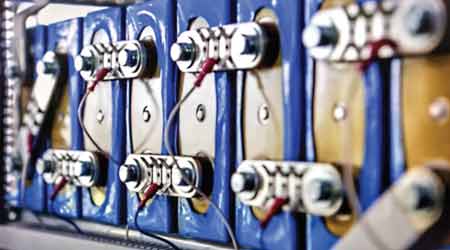3 Benefits of Lithium-Ion Batteries For UPS
Here are three reasons you might: They're smaller and lighter, they have a longer life span, and they don't require ventilation.
Companies are always looking to generate the most revenue from the space they own or lease. More desks are piled into an office to increase headcount. IT racks are filled to capacity. One emerging technology that can help do more with less space is worth considering — lithium-ion batteries in uninterruptible power supply (UPS) systems.
Used to power everything from laptops and cell phones to electric vehicles like the Tesla models, lithium-ion — or LI — batteries are rechargeable and made from one of the world’s most available minerals. Using LI batteries for UPS systems has been known to trim real estate footprint required for batteries by at least 50 percent, while reducing the likelihood of structural reinforcement, and increase battery life by two to three times over traditional lead acid batteries. LI batteries offer other benefits as well, such as built-in battery monitoring.
So why aren’t all data centers using lithium-ion?
• Initial cost. While the expense is coming down, LI batteries do come with a higher price tag versus their valve-regulated lead acid (VRLA) predecessor.
• Perceived safety hazard.
• Hesitation about new technology. Moving away from tried and true methods is a challenge for any facility owner or operator.
But the inefficiencies of traditional VRLA batteries, the real estate they consume, and the cooling they require are draining valuable resources from today’s commercial buildings. It’s time to look ahead — to consider the next horizon in UPS battery solutions.
Until now, LI batteries were costly and only available for UPS systems 200 kW and above, limiting them to projects large in size and deep in funds. In the past few months, however, LI batteries have become available for smaller UPS applications, as small as 50 kW and up. Similarly, costs have dropped more than 70 percent since 2010.
Here are three reasons to consider LI batteries for UPS installation or battery replacement:
1. Smaller and lighter
Lithium-ion batteries weigh 60 to 80 percent less and have a footprint that’s 50 percent smaller than their VRLA counterparts. High-rise buildings, especially older structures that weren’t built for heavy batteries, stand to gain the most from LI batteries: Typically a structural evaluation will show that LI batteries won’t require structural reinforcement. VRLA batteries, on the other hand, often require structural reinforcement because of their bulk and weight. Less real estate allotted to UPS systems means more allotted to revenue generating activities. Eliminating structural reinforcement also means less disruption to other floors/tenants and decreased installation cost.
2. Longer life span
Traditional VRLA batteries last five to seven years, and therefore must be changed two to three times over the lifespan of the UPS system. LI batteries, on the other hand, last the same 10 to 15 years as the UPS. It’s reasonable to say that a UPS system with LI battery power should outlast the average 10-year commercial lease. The result is increased uptime, reliability, and decreased total cost of ownership.
3. No ventilation
LI batteries don’t require ventilation or a segregated room and can therefore remain in the room with the UPS. Per International and NFPA-1 fire codes, traditional VRLA batteries require ventilation to remove their hydrogen exhaust from the area, and therefore are typically housed in a separate room from the UPS they support to limit the amount of ventilation provided; the result is longer conduit runs connecting the two. The cost of ensuring this ventilation can add up, both in real estate — a separate room big enough for the VRLA batteries — and in construction of the necessary duct work and electrical connection between the two.
Related Topics:















